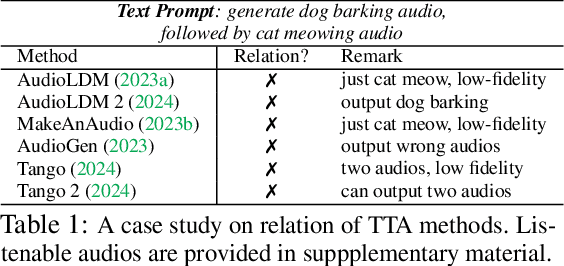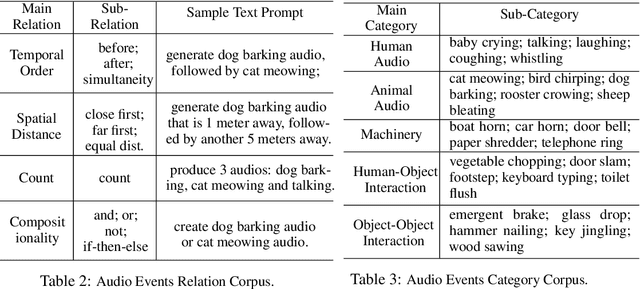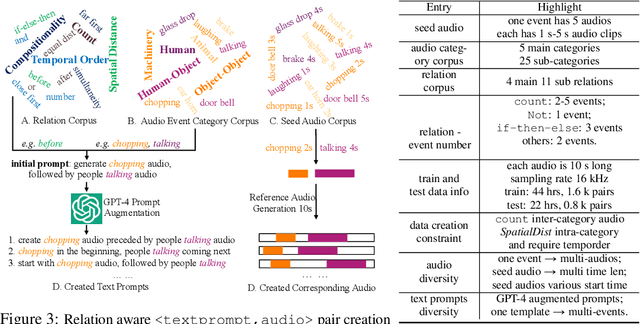Andrew Markham
Efficient and Microphone-Fault-Tolerant 3D Sound Source Localization
May 27, 2025Abstract:Sound source localization (SSL) is a critical technology for determining the position of sound sources in complex environments. However, existing methods face challenges such as high computational costs and precise calibration requirements, limiting their deployment in dynamic or resource-constrained environments. This paper introduces a novel 3D SSL framework, which uses sparse cross-attention, pretraining, and adaptive signal coherence metrics, to achieve accurate and computationally efficient localization with fewer input microphones. The framework is also fault-tolerant to unreliable or even unknown microphone position inputs, ensuring its applicability in real-world scenarios. Preliminary experiments demonstrate its scalability for multi-source localization without requiring additional hardware. This work advances SSL by balancing the model's performance and efficiency and improving its robustness for real-world scenarios.
Target Speaker Extraction through Comparing Noisy Positive and Negative Audio Enrollments
Feb 23, 2025Abstract:Target speaker extraction focuses on isolating a specific speaker's voice from an audio mixture containing multiple speakers. To provide information about the target speaker's identity, prior works have utilized clean audio examples as conditioning inputs. However, such clean audio examples are not always readily available (e.g. It is impractical to obtain a clean audio example of a stranger's voice at a cocktail party without stepping away from the noisy environment). Limited prior research has explored extracting the target speaker's characteristics from noisy audio examples, which may include overlapping speech from disturbing speakers. In this work, we focus on target speaker extraction when multiple speakers are present during the enrollment stage, through leveraging differences between audio segments where the target speakers are speaking (Positive Enrollments) and segments where they are not (Negative Enrollments). Experiments show the effectiveness of our model architecture and the dedicated pretraining method for the proposed task. Our method achieves state-of-the-art performance in the proposed application settings and demonstrates strong generalizability across challenging and realistic scenarios.
SoundLoc3D: Invisible 3D Sound Source Localization and Classification Using a Multimodal RGB-D Acoustic Camera
Dec 22, 2024Abstract:Accurately localizing 3D sound sources and estimating their semantic labels -- where the sources may not be visible, but are assumed to lie on the physical surface of objects in the scene -- have many real applications, including detecting gas leak and machinery malfunction. The audio-visual weak-correlation in such setting poses new challenges in deriving innovative methods to answer if or how we can use cross-modal information to solve the task. Towards this end, we propose to use an acoustic-camera rig consisting of a pinhole RGB-D camera and a coplanar four-channel microphone array~(Mic-Array). By using this rig to record audio-visual signals from multiviews, we can use the cross-modal cues to estimate the sound sources 3D locations. Specifically, our framework SoundLoc3D treats the task as a set prediction problem, each element in the set corresponds to a potential sound source. Given the audio-visual weak-correlation, the set representation is initially learned from a single view microphone array signal, and then refined by actively incorporating physical surface cues revealed from multiview RGB-D images. We demonstrate the efficiency and superiority of SoundLoc3D on large-scale simulated dataset, and further show its robustness to RGB-D measurement inaccuracy and ambient noise interference.
* Accepted by WACV2025
RiTTA: Modeling Event Relations in Text-to-Audio Generation
Dec 20, 2024



Abstract:Despite significant advancements in Text-to-Audio (TTA) generation models achieving high-fidelity audio with fine-grained context understanding, they struggle to model the relations between audio events described in the input text. However, previous TTA methods have not systematically explored audio event relation modeling, nor have they proposed frameworks to enhance this capability. In this work, we systematically study audio event relation modeling in TTA generation models. We first establish a benchmark for this task by: 1. proposing a comprehensive relation corpus covering all potential relations in real-world scenarios; 2. introducing a new audio event corpus encompassing commonly heard audios; and 3. proposing new evaluation metrics to assess audio event relation modeling from various perspectives. Furthermore, we propose a finetuning framework to enhance existing TTA models ability to model audio events relation. Code is available at: https://github.com/yuhanghe01/RiTTA
HyperspectralViTs: General Hyperspectral Models for On-board Remote Sensing
Oct 24, 2024



Abstract:On-board processing of hyperspectral data with machine learning models would enable unprecedented amount of autonomy for a wide range of tasks, for example methane detection or mineral identification. This can enable early warning system and could allow new capabilities such as automated scheduling across constellations of satellites. Classical methods suffer from high false positive rates and previous deep learning models exhibit prohibitive computational requirements. We propose fast and accurate machine learning architectures which support end-to-end training with data of high spectral dimension without relying on hand-crafted products or spectral band compression preprocessing. We evaluate our models on two tasks related to hyperspectral data processing. With our proposed general architectures, we improve the F1 score of the previous methane detection state-of-the-art models by 27% on a newly created synthetic dataset and by 13% on the previously released large benchmark dataset. We also demonstrate that training models on the synthetic dataset improves performance of models finetuned on the dataset of real events by 6.9% in F1 score in contrast with training from scratch. On a newly created dataset for mineral identification, our models provide 3.5% improvement in the F1 score in contrast to the default versions of the models. With our proposed models we improve the inference speed by 85% in contrast to previous classical and deep learning approaches by removing the dependency on classically computed features. With our architecture, one capture from the EMIT sensor can be processed within 30 seconds on realistic proxy of the ION-SCV 004 satellite.
Towards Multi-Modal Animal Pose Estimation: An In-Depth Analysis
Oct 12, 2024



Abstract:Animal pose estimation (APE) aims to locate the animal body parts using a diverse array of sensor and modality inputs, which is crucial for research across neuroscience, biomechanics, and veterinary medicine. By evaluating 178 papers since 2013, APE methods are categorised by sensor and modality types, learning paradigms, experimental setup, and application domains, presenting detailed analyses of current trends, challenges, and future directions in single- and multi-modality APE systems. The analysis also highlights the transition between human and animal pose estimation. Additionally, 2D and 3D APE datasets and evaluation metrics based on different sensors and modalities are provided. A regularly updated project page is provided here: https://github.com/ChennyDeng/MM-APE.
MambaLoc: Efficient Camera Localisation via State Space Model
Aug 20, 2024Abstract:Location information is pivotal for the automation and intelligence of terminal devices and edge-cloud IoT systems, such as autonomous vehicles and augmented reality. However, achieving reliable positioning across diverse IoT applications remains challenging due to significant training costs and the necessity of densely collected data. To tackle these issues, we have innovatively applied the selective state space (SSM) model to visual localization, introducing a new model named MambaLoc. The proposed model demonstrates exceptional training efficiency by capitalizing on the SSM model's strengths in efficient feature extraction, rapid computation, and memory optimization, and it further ensures robustness in sparse data environments due to its parameter sparsity. Additionally, we propose the Global Information Selector (GIS), which leverages selective SSM to implicitly achieve the efficient global feature extraction capabilities of Non-local Neural Networks. This design leverages the computational efficiency of the SSM model alongside the Non-local Neural Networks' capacity to capture long-range dependencies with minimal layers. Consequently, the GIS enables effective global information capture while significantly accelerating convergence. Our extensive experimental validation using public indoor and outdoor datasets first demonstrates our model's effectiveness, followed by evidence of its versatility with various existing localization models. Our code and models are publicly available to support further research and development in this area.
SPEAR: Receiver-to-Receiver Acoustic Neural Warping Field
Jun 16, 2024



Abstract:We present SPEAR, a continuous receiver-to-receiver acoustic neural warping field for spatial acoustic effects prediction in an acoustic 3D space with a single stationary audio source. Unlike traditional source-to-receiver modelling methods that require prior space acoustic properties knowledge to rigorously model audio propagation from source to receiver, we propose to predict by warping the spatial acoustic effects from one reference receiver position to another target receiver position, so that the warped audio essentially accommodates all spatial acoustic effects belonging to the target position. SPEAR can be trained in a data much more readily accessible manner, in which we simply ask two robots to independently record spatial audio at different positions. We further theoretically prove the universal existence of the warping field if and only if one audio source presents. Three physical principles are incorporated to guide SPEAR network design, leading to the learned warping field physically meaningful. We demonstrate SPEAR superiority on both synthetic, photo-realistic and real-world dataset, showing the huge potential of SPEAR to various down-stream robotic tasks.
Pre-training Feature Guided Diffusion Model for Speech Enhancement
Jun 11, 2024Abstract:Speech enhancement significantly improves the clarity and intelligibility of speech in noisy environments, improving communication and listening experiences. In this paper, we introduce a novel pretraining feature-guided diffusion model tailored for efficient speech enhancement, addressing the limitations of existing discriminative and generative models. By integrating spectral features into a variational autoencoder (VAE) and leveraging pre-trained features for guidance during the reverse process, coupled with the utilization of the deterministic discrete integration method (DDIM) to streamline sampling steps, our model improves efficiency and speech enhancement quality. Demonstrating state-of-the-art results on two public datasets with different SNRs, our model outshines other baselines in efficiency and robustness. The proposed method not only optimizes performance but also enhances practical deployment capabilities, without increasing computational demands.
ZeST: Zero-Shot Material Transfer from a Single Image
Apr 09, 2024Abstract:We propose ZeST, a method for zero-shot material transfer to an object in the input image given a material exemplar image. ZeST leverages existing diffusion adapters to extract implicit material representation from the exemplar image. This representation is used to transfer the material using pre-trained inpainting diffusion model on the object in the input image using depth estimates as geometry cue and grayscale object shading as illumination cues. The method works on real images without any training resulting a zero-shot approach. Both qualitative and quantitative results on real and synthetic datasets demonstrate that ZeST outputs photorealistic images with transferred materials. We also show the application of ZeST to perform multiple edits and robust material assignment under different illuminations. Project Page: https://ttchengab.github.io/zest
 Add to Chrome
Add to Chrome Add to Firefox
Add to Firefox Add to Edge
Add to Edge